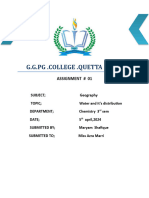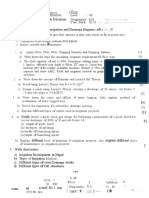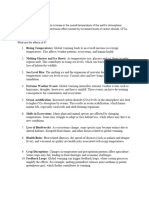0 ratings0% found this document useful (0 votes)
69 viewsWater
Water
Uploaded by
GKalai ArasiWater is a transparent fluid that makes up the world's streams, lakes, oceans and rain. It is the major constituent of fluids in living things. A water molecule contains one oxygen atom and two hydrogen atoms connected by covalent bonds. Water exists as a liquid at standard temperature and pressure but also as a solid (ice) and gas (water vapor) on Earth. It covers 71% of the Earth's surface, with 96.5% found in oceans and seas, 1.7% in groundwater, 1.7% in glaciers and ice sheets, and small amounts in other bodies and air vapor. Only 2.5% of Earth's water is freshwater.
Copyright:
© All Rights Reserved
Available Formats
Download as DOCX, PDF, TXT or read online from Scribd
Water
Water
Uploaded by
GKalai Arasi0 ratings0% found this document useful (0 votes)
69 views1 pageWater is a transparent fluid that makes up the world's streams, lakes, oceans and rain. It is the major constituent of fluids in living things. A water molecule contains one oxygen atom and two hydrogen atoms connected by covalent bonds. Water exists as a liquid at standard temperature and pressure but also as a solid (ice) and gas (water vapor) on Earth. It covers 71% of the Earth's surface, with 96.5% found in oceans and seas, 1.7% in groundwater, 1.7% in glaciers and ice sheets, and small amounts in other bodies and air vapor. Only 2.5% of Earth's water is freshwater.
Original Description:
english
Copyright
© © All Rights Reserved
Available Formats
DOCX, PDF, TXT or read online from Scribd
Share this document
Did you find this document useful?
Is this content inappropriate?
Water is a transparent fluid that makes up the world's streams, lakes, oceans and rain. It is the major constituent of fluids in living things. A water molecule contains one oxygen atom and two hydrogen atoms connected by covalent bonds. Water exists as a liquid at standard temperature and pressure but also as a solid (ice) and gas (water vapor) on Earth. It covers 71% of the Earth's surface, with 96.5% found in oceans and seas, 1.7% in groundwater, 1.7% in glaciers and ice sheets, and small amounts in other bodies and air vapor. Only 2.5% of Earth's water is freshwater.
Copyright:
© All Rights Reserved
Available Formats
Download as DOCX, PDF, TXT or read online from Scribd
Download as docx, pdf, or txt
0 ratings0% found this document useful (0 votes)
69 views1 pageWater
Water
Uploaded by
GKalai ArasiWater is a transparent fluid that makes up the world's streams, lakes, oceans and rain. It is the major constituent of fluids in living things. A water molecule contains one oxygen atom and two hydrogen atoms connected by covalent bonds. Water exists as a liquid at standard temperature and pressure but also as a solid (ice) and gas (water vapor) on Earth. It covers 71% of the Earth's surface, with 96.5% found in oceans and seas, 1.7% in groundwater, 1.7% in glaciers and ice sheets, and small amounts in other bodies and air vapor. Only 2.5% of Earth's water is freshwater.
Copyright:
© All Rights Reserved
Available Formats
Download as DOCX, PDF, TXT or read online from Scribd
Download as docx, pdf, or txt
You are on page 1of 1
Water is a transparent fluid which forms the world's streams, lakes, oceans and rain, and is the
major constituent of the fluids of living things. As a chemical compound, a water
molecule contains one oxygen and two hydrogen atoms that are connected by covalent bonds.
Water is a liquid at standard ambient temperature and pressure, but it often co-exists
on Earth with its solid state, ice; and gaseous state,steam (water vapor). It also exists
as snow, fog, dew and cloud
Water covers 71% of the Earth's surface.[1] It is vital for all known forms of life. On Earth, 96.5% of
the planet's water is found in seas and oceans, 1.7% in groundwater, 1.7% in glaciers and the ice
caps of Antarctica and Greenland, a small fraction in other large water bodies, and 0.001% in
the air as vapor, clouds (formed of solid and liquid water particles suspended in air),
and precipitation.[2][3] Only 2.5% of the Earth's water is freshwater, and 98.8% of that water is in
ice and groundwater. Less than 0.3% of all freshwater is in rivers, lakes, and the atmosphere,
and an even smaller amount of the Earth's freshwater (0.003%) is contained within biological
bodies and manufactured products
You might also like
- Qatar Storm Drainage ManualDocument97 pagesQatar Storm Drainage Manualkashif100% (3)
- Glacier Travel and Crevasse RescueDocument80 pagesGlacier Travel and Crevasse RescueMohamed F. AbdullahNo ratings yet
- Lines of Latitude and Longitude WorksheetDocument9 pagesLines of Latitude and Longitude Worksheetrenegade 1No ratings yet
- Water Is A Transparent and Nearly Colorless O, Meaning That ItsDocument1 pageWater Is A Transparent and Nearly Colorless O, Meaning That ItsUsman SayyedNo ratings yet
- Water Is A Transparent and Nearly Colorless O, Meaning That ItsDocument2 pagesWater Is A Transparent and Nearly Colorless O, Meaning That ItsJitender KumarNo ratings yet
- WaterDocument2 pagesWaterjatothuNo ratings yet
- Water: By:Ashha Kayla Almirah Grade:4ADocument2 pagesWater: By:Ashha Kayla Almirah Grade:4AEly SuzanaNo ratings yet
- Water Is A Transparent and Nearly Colorless O, Meaning That ItsDocument1 pageWater Is A Transparent and Nearly Colorless O, Meaning That ItsNaditaNo ratings yet
- Water Is A Transparent, Tasteless, Odorless, and Nearly ColorlessDocument1 pageWater Is A Transparent, Tasteless, Odorless, and Nearly ColorlessaaNo ratings yet
- Water ProofDocument1 pageWater Proofelek kissNo ratings yet
- Water: Water Is The Transparent, Tasteless, Odorless, and Nearly ColorlessDocument1 pageWater: Water Is The Transparent, Tasteless, Odorless, and Nearly ColorlessasdNo ratings yet
- Water Is A Transparent Fluid Which Forms The World's Streams, Lakes, Oceans and Rain, and Is TheDocument1 pageWater Is A Transparent Fluid Which Forms The World's Streams, Lakes, Oceans and Rain, and Is Thesivakishore1234No ratings yet
- Test 1Document1 pageTest 1bobbyNo ratings yet
- Water (Chemical Formula: H O) Is A Transparent Fluid Which Forms The World's Streams, Lakes, Oceans andDocument1 pageWater (Chemical Formula: H O) Is A Transparent Fluid Which Forms The World's Streams, Lakes, Oceans andBheo BellyNo ratings yet
- Water: Jump To Navigation Jump To SearchDocument2 pagesWater: Jump To Navigation Jump To Searchrjohn 7No ratings yet
- WaterDocument1 pageWaterNatasha DelgadoNo ratings yet
- Water Is A O. ADocument1 pageWater Is A O. AAeon FluxNo ratings yet
- WaterDocument1 pageWaterbrlonjaytNo ratings yet
- Fluctuations in TemperatureDocument9 pagesFluctuations in TemperatureVarsha Raut-BharadNo ratings yet
- WaterDocument1 pageWaterAlizay AamirNo ratings yet
- HYDROSPHEREDocument2 pagesHYDROSPHEREhrhishere8No ratings yet
- Water: From Wikipedia, The Free EncyclopediaDocument1 pageWater: From Wikipedia, The Free Encyclopediascribd388No ratings yet
- WaterDocument1 pageWaterSergio AgredoNo ratings yet
- This Article Is About General Aspects of WaterDocument1 pageThis Article Is About General Aspects of WatermsaffankbNo ratings yet
- Water Is A Chemical Substance With The Chemical Formula H O. Its Molecule Contains One OxygenDocument3 pagesWater Is A Chemical Substance With The Chemical Formula H O. Its Molecule Contains One OxygenCrusina MaataNo ratings yet
- Abiotic WaterDocument3 pagesAbiotic WaterAzizul HakimNo ratings yet
- Water, AnyDocument11 pagesWater, AnyRamli AbdullahNo ratings yet
- CEG503SurfaceWaterHydrology-Lecture 1 Hydrological Cycle 2018semesterDocument19 pagesCEG503SurfaceWaterHydrology-Lecture 1 Hydrological Cycle 2018semesterOMOGBEHIN SEUNNo ratings yet
- Water 5Document5 pagesWater 5Rey Jr. Cobel CababasadaNo ratings yet
- WaterDocument2 pagesWatergnoble30No ratings yet
- Types of WaterDocument23 pagesTypes of WaterTSha MeunierNo ratings yet
- Earth Science MLG 4Document19 pagesEarth Science MLG 4Racquel BanaoNo ratings yet
- Water in GeographyDocument5 pagesWater in Geographymaryam achakzaiNo ratings yet
- WaterDocument2 pagesWaterfdbp42kfs6No ratings yet
- Earth SciDocument20 pagesEarth SciClowohNo ratings yet
- Water: H2O (Disambiguation) HOH (Disambiguation)Document35 pagesWater: H2O (Disambiguation) HOH (Disambiguation)dulyu4uNo ratings yet
- Sanitation, Plumbing Design, and InstallationDocument12 pagesSanitation, Plumbing Design, and InstallationHaRriet De Guzman VillanuevaNo ratings yet
- Types and Properties of WaterDocument4 pagesTypes and Properties of WaterQdlm KnocNo ratings yet
- Spheres of The Earth: HydrosphereDocument14 pagesSpheres of The Earth: HydrosphereFarehinNo ratings yet
- Vii Geo L05 M01 Water HandoutDocument4 pagesVii Geo L05 M01 Water Handoutyabish312No ratings yet
- Water Water Is Tramparent, Tasteless, Odorless, and Nearly Colorless Chemical Substance That Is The MainDocument2 pagesWater Water Is Tramparent, Tasteless, Odorless, and Nearly Colorless Chemical Substance That Is The MainHelmi YudistiraNo ratings yet
- Water Is A Transparent, Tasteless, Odorless, and Nearly ColorlessDocument1 pageWater Is A Transparent, Tasteless, Odorless, and Nearly ColorlessSaad AhsanNo ratings yet
- HydrosphereDocument20 pagesHydrospheresignal jammerNo ratings yet
- ESL0101 Unit IIDocument45 pagesESL0101 Unit IIBABU RAONo ratings yet
- The Water Molecule: Are The Outside Valences Full?Document3 pagesThe Water Molecule: Are The Outside Valences Full?maryaniNo ratings yet
- Water ResourcesDocument33 pagesWater ResourcesJolina RicoNo ratings yet
- Natural Environment: Navigation SearchDocument16 pagesNatural Environment: Navigation SearchChong Ru YinNo ratings yet
- Sources: Water Distribution On EarthDocument3 pagesSources: Water Distribution On Earthbrendan lanzaNo ratings yet
- Angel 5Document2 pagesAngel 5anon_874156217No ratings yet
- VRB JishaDocument35 pagesVRB Jishaupendra1616No ratings yet
- Water: Water Is A CommonDocument28 pagesWater: Water Is A CommonVel MuruganNo ratings yet
- SCE 201 (Marine Science)Document37 pagesSCE 201 (Marine Science)allanlopez_2009100% (1)
- Water Use and The EnvironmentDocument150 pagesWater Use and The EnvironmentTejaswiniNo ratings yet
- Types and Propertes of WaterDocument12 pagesTypes and Propertes of WaterTejaswiniNo ratings yet
- Properties of Water 5Document3 pagesProperties of Water 5Anonymous QM0NLqZONo ratings yet
- Geo 4 SpheresDocument9 pagesGeo 4 Spheresapi-266434967No ratings yet
- Hydro SphereDocument33 pagesHydro SphereAlvinNo ratings yet
- Written Report HydrologyDocument4 pagesWritten Report Hydrologylanie mondiaNo ratings yet
- WATRES - PPT 1-IntroDocument54 pagesWATRES - PPT 1-IntroMichael GuancoNo ratings yet
- Scientific Overview of WaterDocument2 pagesScientific Overview of WaterTommyNo ratings yet
- Distribution of Water On EarthDocument8 pagesDistribution of Water On EarthScribdTranslationsNo ratings yet
- Why Does It Happen?: Oceans, Seas, Lakes and Rivers: Oceanography for KidsFrom EverandWhy Does It Happen?: Oceans, Seas, Lakes and Rivers: Oceanography for KidsNo ratings yet
- Peta Buih BentukDocument7 pagesPeta Buih BentukGKalai ArasiNo ratings yet
- SLIDE SKPM (2)Document12 pagesSLIDE SKPM (2)GKalai ArasiNo ratings yet
- LAPORAN RPH (PDPR) KALAY (M 28) 15 - 19.8. 2021Document20 pagesLAPORAN RPH (PDPR) KALAY (M 28) 15 - 19.8. 2021GKalai ArasiNo ratings yet
- LAPORAN RPH (PDPR) KALAY - (M 26) 01 - 05.08 2021Document20 pagesLAPORAN RPH (PDPR) KALAY - (M 26) 01 - 05.08 2021GKalai ArasiNo ratings yet
- Presentation 2Document8 pagesPresentation 2GKalai ArasiNo ratings yet
- A Good Teacher Is Like A Candle StoryDocument19 pagesA Good Teacher Is Like A Candle StoryGKalai ArasiNo ratings yet
- Rights Under The ConventionDocument7 pagesRights Under The ConventionGKalai ArasiNo ratings yet
- How To Apply LipstickDocument1 pageHow To Apply LipstickGKalai ArasiNo ratings yet
- Perennial Genus Rosaceae Species Cultivars Prickles: For Other Uses, See - "Roses" Redirects Here. For Other Uses, SeeDocument1 pagePerennial Genus Rosaceae Species Cultivars Prickles: For Other Uses, See - "Roses" Redirects Here. For Other Uses, SeeGKalai ArasiNo ratings yet
- perennial genus Rosaceae species cultivars prickles: varəδa,Document1 pageperennial genus Rosaceae species cultivars prickles: varəδa,GKalai ArasiNo ratings yet
- Jadual Tugas (Ajk Pertandigan) : Pertandingan In-Charge (Pertandingan) In-Charge (Pameran)Document1 pageJadual Tugas (Ajk Pertandigan) : Pertandingan In-Charge (Pertandingan) In-Charge (Pameran)GKalai ArasiNo ratings yet
- Awards For Water Filtration Company of The Year. This Award Is AkinDocument1 pageAwards For Water Filtration Company of The Year. This Award Is AkinGKalai ArasiNo ratings yet
- 1881 and 1949 Earthquakes at The Chios-Cesme Strait (Aegean Sea)Document9 pages1881 and 1949 Earthquakes at The Chios-Cesme Strait (Aegean Sea)Stauros StephanidesNo ratings yet
- Mination Division: ControlDocument20 pagesMination Division: ControlRaghu Nath PrajapatiNo ratings yet
- UsingLandsatTMdataforSoil Moisture Mapping PDFDocument22 pagesUsingLandsatTMdataforSoil Moisture Mapping PDFnayaka19No ratings yet
- LouisianaDocument4 pagesLouisianaRosselle Joy MartinezNo ratings yet
- 0 - Proforma STAL2522 2014-2015Document4 pages0 - Proforma STAL2522 2014-2015VAlentino AUrishNo ratings yet
- 20-21 Geo Mid Year Question SheetDocument4 pages20-21 Geo Mid Year Question SheetnatalieNo ratings yet
- What Is Global WarmingDocument3 pagesWhat Is Global Warmingsamihahadj194No ratings yet
- Weather Key AnswerDocument1 pageWeather Key Answerjoury2008abidNo ratings yet
- Tropical Design 1Document64 pagesTropical Design 1Ian Paolo D. RuñezNo ratings yet
- BIO3119-Marine & Coastal Ecology: Lecture 6: Coastal Processes Lecturer: Mark RamDocument43 pagesBIO3119-Marine & Coastal Ecology: Lecture 6: Coastal Processes Lecturer: Mark RamNaiomiNo ratings yet
- The Weather in GuatemalaDocument1 pageThe Weather in GuatemalaCelia CastilloNo ratings yet
- ResearchDocument3 pagesResearchMervin AlbercaNo ratings yet
- Presentation - Understanding Common HazardsDocument17 pagesPresentation - Understanding Common HazardsSHERYL WYCOCONo ratings yet
- Geomorphology PresentationDocument12 pagesGeomorphology PresentationKashish KeshariNo ratings yet
- T TP 2549003 Cbeebies Go Jetters Continent of South America Powerpoint Ver 7Document24 pagesT TP 2549003 Cbeebies Go Jetters Continent of South America Powerpoint Ver 7richard.cronin.1092No ratings yet
- Bridge EssayDocument5 pagesBridge Essayoliveck10No ratings yet
- Chapter 4Document30 pagesChapter 4limuelNo ratings yet
- Outstanding Universal Value: Puerto-Princesa Subterranean River National ParkDocument3 pagesOutstanding Universal Value: Puerto-Princesa Subterranean River National ParkI'm a Smart CatNo ratings yet
- The Types of CloudsDocument7 pagesThe Types of CloudsChristopher Enriquez100% (1)
- Ben Avraham and Emery 1973 - Structural Framework of Sunda ShelfDocument44 pagesBen Avraham and Emery 1973 - Structural Framework of Sunda ShelfionizedxNo ratings yet
- DELTA - PSSG Amoguis, Robie JaneDocument1 pageDELTA - PSSG Amoguis, Robie JanelgmaisogNo ratings yet
- Planning & Designing Green School GroundsDocument64 pagesPlanning & Designing Green School Groundsmohammed hassainNo ratings yet
- DẠNG 2. TÌM LỖI SAI ĐỀ SỐ 11Document3 pagesDẠNG 2. TÌM LỖI SAI ĐỀ SỐ 11ThngNo ratings yet
- Lemonade StandDocument8 pagesLemonade StandRyanbraun29No ratings yet
- Climate Change Related Statistics - India 29nov13 PDFDocument280 pagesClimate Change Related Statistics - India 29nov13 PDFShashwath GuptaNo ratings yet
- Klasifikasi Tanah FineDocument5 pagesKlasifikasi Tanah Finenurdiyanto suryaNo ratings yet




































































































